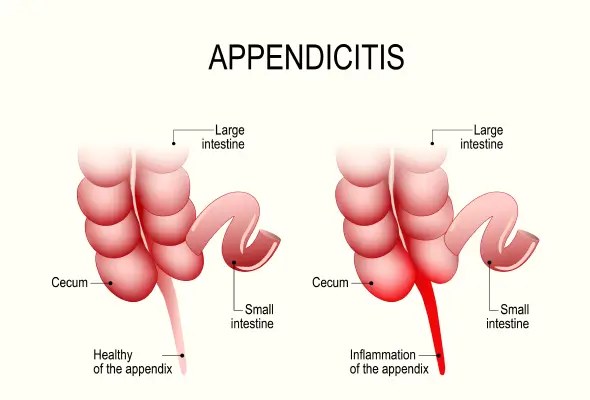-
Doctors
-
Specialities & Treatments
Centre of Excellence
Specialties
Treatments and Procedures
Hospitals & Directions HyderabadCARE Hospitals, Banjara Hills CARE Outpatient Centre, Banjara Hills CARE Hospitals, HITEC City CARE Hospitals, Nampally Gurunanak CARE Hospitals, Musheerabad CARE Hospitals Outpatient Centre, HITEC City CARE Hospitals, Malakpet
HyderabadCARE Hospitals, Banjara Hills CARE Outpatient Centre, Banjara Hills CARE Hospitals, HITEC City CARE Hospitals, Nampally Gurunanak CARE Hospitals, Musheerabad CARE Hospitals Outpatient Centre, HITEC City CARE Hospitals, Malakpet Raipur
Raipur
 Bhubaneswar
Bhubaneswar Visakhapatnam
Visakhapatnam
 Nagpur
Nagpur
 Indore
Indore
 Chh. Sambhajinagar
Chh. SambhajinagarClinics & Medical Centers
Book an AppointmentContact Us
Online Lab Reports
Book an Appointment
Consult Super-Specialist Doctors at CARE Hospitals

Appendicitis in Children
Symptom, Causes, Diagnosis and Treatment
Appendicitis in Children
Appendicitis affects millions of school-going children in the world each year. Understanding the causes of appendicitis in children is crucial for parents and caregivers. This condition, which involves inflammation of the appendix, can be fatal if not treated promptly. Recognising the signs and symptoms of appendicitis in children is key to ensuring timely medical intervention and preventing potential health risks.
Let's delve into the common causes, discuss the telltale symptoms to watch for, and outline doctors' diagnostic processes.

What is Appendicitis?
This condition is an inflammation of the appendix, a finger-shaped tube-like pouch attached to the first part of the large intestine. This condition occurs when the appendix becomes blocked, leading to infection and swelling. The appendix is located in the lower right side of the abdomen. As the inflammation worsens, the blood supply to the appendix decreases, potentially leading to tissue necrosis. Individuals usually feel mild pain around the belly button, which moves to the right lower abdomen and worsens with time.

How Common is Appendicitis in Children?
Appendicitis is very relatively common in children, typically developing between the ages of 10 and 19, accounting for 7-8% of the children population experience acute appendicitis in children. It is one of the most frequent causes of abdominal pain that leads to emergency hospital visits in this age group.
What Causes Appendicitis in Children?
The causes of appendicitis in children often stem from a blockage in the appendix. This obstruction can result from various factors:
- Hard faecal material, known as a fecalith, may accumulate and block the appendix opening.
- Swollen lymph nodes in the intestine can occur due to infections. They can also impact the development of appendicitis.
- In some cases, mucus buildup or parasites contribute to the blockage.
- The obstruction leads to bacterial growth within the appendix, causing inflammation and swelling. As the condition worsens, the blood supply to the appendix decreases, potentially resulting in tissue death.
- If left untreated, the appendix may burst, spreading bacteria throughout the abdomen and causing a serious infection called peritonitis.
- Other less common causes include swallowed foreign objects and certain types of cancer. Recognising the signs of appendicitis in children is crucial for prompt medical intervention.
Symptoms of Appendicitis in Children
The following are some common appendicitis symptoms in children:
- Abdominal Pain: The condition usually begins with a vague discomfort around the belly button, which then moves to the lower right side of the abdomen. This pain often becomes more severe with movement or activity.
- Fever: Children may experience nausea, vomiting, and a low-grade fever (100 to 101°F).
- Change in Bowel Habit: children may have poor appetite, and some may experience diarrhoea, especially small amounts of mucus.
- Behavioural Changes: Parents should watch for behavioural changes, such as irritability or disinterest in eating, particularly in younger children who may struggle to communicate their symptoms effectively.
- Tenderness: The child's abdomen may be tender to the touch, especially in the lower right quadrant. Sometimes, children may feel more pain when pressure is released from the abdomen, which is a conclusive appendicitis symptom in children.
- The 'jump test' can be helpful; if jumping intensifies the pain, it might indicate appendicitis.
- In rare cases, a high fever reaching 104°F could signal a burst appendix, requiring immediate medical attention.
Diagnosis
Diagnosing appendicitis in children includes a combination of clinical evaluation and diagnostic tests:
- Medical History and Physical Examination: The doctor will ask about the child's symptoms, including the location and duration of abdominal pain, appetite changes, and medical history. Doctors will conduct a physical examination, focusing on abdominal pain and tenderness signs.
- Laboratory Tests: Blood and urine investigations are often prescribed to check for infection or inflammation.
- Imaging Tests: Ultrasound is the preferred initial imaging method in children, as it doesn't expose them to radiation. Doctors may ask for a CT scan or MRI if ultrasound results are inconclusive. During the diagnostic process, children are usually asked to avoid eating or drinking in case surgery becomes necessary.
Treatment for Appendicitis in Children
The primary treatment for appendicitis in children is surgical removal of the appendix or appendectomy. This procedure is usually performed as soon as possible to prevent complications. Surgeons may use one of two methods: laparoscopic or open surgery.
During laparoscopic surgery, the surgeon makes small incisions and does the procedure, resulting in a shorter recovery time and lower infection rate. Open surgery requires a larger incision and is often used for more complex cases.
In some cases, particularly with early or mild appendicitis, doctors may opt for non-operative treatment using antibiotics alone. This approach allows children to avoid surgery and return to normal activities sooner.
Complications
Appendicitis in children can lead to severe complications if left untreated.
The most critical complication is a ruptured appendix, which can occur within hours of the initial symptoms. This emergency has the potential to be fatal. When the appendix ruptures, bacteria spread throughout the abdominal cavity, causing peritonitis, a serious bacterial infection that can rapidly progress and become challenging to treat if delayed diagnosis.
Other complications include:
- Perforation
- Septic shock
- Pelvic abscesses
- Wound infections
- Bowel obstructions
In some cases, chronic appendicitis can develop, presenting as prolonged or intermittent abdominal pain. This condition can result in intra-abdominal infections or bowel obstruction if not correctly diagnosed and treated.
When to See a Doctor
Appendicitis is a medical emergency that warrants immediate attention. Parents should seek medical care right away if they suspect their child has appendicitis. The sooner it is diagnosed, the easier it becomes to treat. It's crucial to watch for signs of appendicitis in children, such as abdominal pain in the lower right quadrant that worsens over time. Other symptoms include nausea, fever, and abdominal tenderness. A high fever reaching 104°F (40°C) might indicate a burst appendix, which needs urgent medical care.
Conclusion
Appendicitis in children remains a significant health concern that has an impact on thousands of young patients yearly. Prompt identification of symptoms and timely medical intervention can prevent complications and ensure positive outcomes. Parents & caregivers play a vital role in identifying early signs of appendicitis, such as abdominal pain, nausea, and fever. They can make well-informed decisions about their child's health by staying informed about the causes, risk factors, and treatment options.
FAQ's
1. How do I know if my child has appendicitis?
Appendicitis pain in children often begins with vague discomfort around the belly button, which then moves to the lower right side of the abdomen. The pain typically worsens with movement. Other signs include nausea, vomiting, low-grade fever, and loss of appetite. Parents should watch for behavioural changes, such as irritability or disinterest in eating, especially in younger children who may struggle to communicate their symptoms effectively.
2. Can appendicitis be treated without surgery?
In some cases, doctors can treat uncomplicated appendicitis in children using antibiotics alone. However, there's a chance of recurrence within the next ten years, so most parents opt for surgical removal of the appendix (appendectomy).
3. How long does it take a child to recover from appendicitis?
After an appendectomy, most children can return to school within 1 to 2 days and resume normal activities within 2 to 3 weeks. However, lifting weights over 10 pounds and participating in competitive sports should be avoided for at least two weeks after surgery.
4. What is the normal size of an appendix in a child?
The normal size of an appendix in children varies with age. Recent studies suggest that normal paediatric appendixes can measure up to 8.7 millimetres, with up to 39% measuring more than 6 millimetres in diameter. The appendix diameter increases by about 0.4 mm per year until 6-7 years of age, after which it remains stable.
Still Have a Question?




